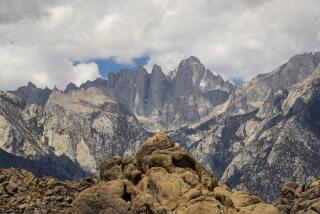Missteps That Doom Hikers
- Share via
All too often, family members or friends describe them as “experienced hikers.” Some are. But experience does little good unless it’s accompanied by sound judgment. The best decision a mountain traveler can make is to know when it’s time to turn around and head back to the lowlands. Even better is not to go at all when conditions are potentially dangerous. Sadly, that has not happened in Southern California in recent days. At least four area hikers have been found dead since the start of the year, and too many others are missing.
In Northern California, calls for search-and-rescue teams have run far higher than normal. In one weekend, a cross-country skier was killed by an avalanche near Donner Summit and another barely escaped from sliding snow. And six wayward skiers and snowboarders spent a bitter cold night in the Lake Tahoe area before rescue teams found them the next day.
The weather has been a major factor. In the northern Sierra, it was heavy snow. In the south, it has been dangerous, icy conditions. Prospective hikers were warned not to venture into areas of the San Bernardino, Cleveland, Angeles and Los Padres national forests. One official cautioned, “It’s just a sheet of ice up there.” Hikers, though, were deceived and lured by sunshine. “It’s beautiful out there,” said experienced hiker Lori Ives, but “the mountains don’t care.”
One hiker who was still missing Friday was described as experienced, but a search-team member said that he was really more of an “enthusiast.” He was trying out ice-climbing gear that he got for Christmas, but he had no experience or practice using it and was hiking alone -- a recipe for disaster.
Savvy hikers check weather forecasts. They ask rangers, before venturing out, about snow or ice. They pack enough gear and emergency equipment to survive one or more nights stranded in the cold. They always leave word with friends or family about where they are going and when they should be expected back. This information helps search teams focus on the most likely area where a missing hiker might be. Cellphones can be used to summon help when needed, but the high-tech gadgets often don’t work in wilderness areas.
A hiker or climber’s attitude and awareness are critical. If the going gets tough, outdoor enthusiasts cannot assume that conditions will get better if they push on; invariably things get worse, if for no other reason than that darkness falls early on these winter days. Ultimately, a single step may save hikers from injury or death. That’s the one that points them in the other direction, toward home.
More to Read
Sign up for The Wild
We’ll help you find the best places to hike, bike and run, as well as the perfect silent spots for meditation and yoga.
You may occasionally receive promotional content from the Los Angeles Times.






